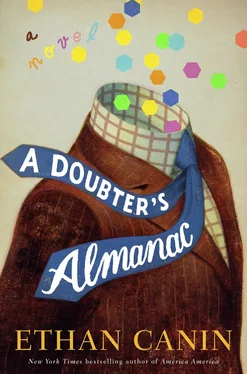In those days, as it happened, the broader discipline of topology was at the apex of its ascendance. The field had become prominent at the turn of the century with the publication of “Analysis Situs,” and in the following decades it had only grown in eminence, not just among mathematicians but among scholars of every branch of the natural sciences. The years leading up to his arrival at Princeton had charted themselves perfectly for the wave of new thinkers who were beginning to populate the upper levels of the universities. These men were no longer bound by symbology but instead spent their days constructing complicated hypothetical shapes that had never before been seen — nor likely imagined — by the human mind. Topologists built undrawable figures in their imaginations, then twisted and folded them. They devoted their time to inventing a cosmology in which the world as it was known — the world of earth and sea and sky — was no more than the three-dimensional rendering of an infinitely higher-dimensional space, much as a two-dimensional movie screen might appear to hold a three-dimensional tableau. In the new paradigm, sensory experience counted for nothing. Pure mathematical ingenuity — the ability to ignore common understanding, to construct a world solely from derived principles — had begun to supersede empiricism.
The field itself required a particular mode of thinking. Not merely the standard mathematical skills but a visual dexterity that could retain complex constructions in the mind for long periods of time, transforming certain parameters while leaving others intact. It was a strenuous and disobliging intellectual endeavor, a sea change of thought in which the brain performed multidimensional mapping. There were topologists who could build architectural structures in their imaginations, then turn them over, then flip them inside out, then spin them around, then open them up and go inside them.
Andret’s own gift for such internal rendering seemed to him to be a derivative of the old positional sense that had once located him in the woods. And not only did it guide him now when he pictured objects in his mind, but also when he drew them with his pencil. He found that he could begin any topological rendering at the upper corner of a sheet of paper and proceed diagonally down to its opposite. No matter how complex the figure, no matter how many layerings of foreground and middleground and background interceded, he could steadily bring to life an entire theoretical construction, with all its dapplings and stipplings, depicting shadow and volume and transformation, in a single, angled pass. It was an astonishing aptitude, really. As far as he knew, nobody else in the department possessed it.
He’d been equally capable of it during his years at Berkeley, of course, but he’d rarely had the opportunity to use it; none of his peers and none of the faculty had even been aware he could do it — not even Borland — and Andret himself had been no more impressed by it than he would have been on any given morning to see his unexceptional face in the mirror.
At Princeton, on the other hand, midway through the semester, he’d been approached at an outdoor café by one of the endowed professors and asked to produce a fully rotated rendering of a Steiner surface, which was formed from the smoothed union of three hyperbolic paraboloids. Andret had complied immediately, sliding a cocktail napkin to the center of the table and using the pen from his jacket pocket to move without hesitation from the top left of the paper to the bottom right. When he’d finished, the professor said, simply, “Remarkable.” For a few moments, the two of them exchanged pleasantries. Then the professor left, taking the napkin with him.
Yet equally remarkable was the fact that until this point in his life Andret had felt little desire to avail himself of such a talent. He never drew the world around him. Not trees. Not landscapes. Not the human figure. Never the land and never the lake or the woods he’d grown up with. Never the faces he knew. As a child he hadn’t entertained the slightest feeling toward art, and as an adult he’d remained entirely unmoved by the world of the visual. Princeton had an art museum. He would never have considered spending an afternoon there.
—
BY THE MIDDLE of the winter, he’d narrowed his search to the Abendroth and two other possibilities. One was the Goldbach conjecture, a problem in number theory that had been around since Goldbach first posed it to Euler. Its statement was simple— Every even integer greater than 2 can be expressed as the sum of two primes —yet a dozen generations of mathematicians had worked on it without finding a proof.
The first Kurtman hypothesis, on the other hand, was the product of a man who was still on the faculty at the Free University of Berlin. Andret had only learned of its existence when he’d stumbled upon Dietrich Kurtman’s face on the cover of a copy of Der Spiegel that was sitting on a coffee table in the department offices.
A mathematician on the cover of an international magazine. He’d felt his bile rise.
But in the end, he concluded, both the Goldbach and the first Kurtman were problems of number theory. He liked numbers, but he wasn’t a number theorist. He was a topologist. Hans Borland had seen it in him.
He would need to be disciplined now. He would need to make the wise choice.
Late in January, at the depth of the winter’s cold, he put away his notes on the Goldbach and the first Kurtman. He cleaned his office. Into a drawer he brushed everything from his side table, then taped together a file box. On the cover of the box he printed the words ABENDROTH CONJECTURE: 1977–19—. He had a feeling that Ulrich Abendroth had proposed a problem that might not be solved for decades; but he pulled the table alongside his desk anyway and set the file box on top of it.
SITTING IN HIS warm office, he would begin by layering figures in his mind. When he reached the end of a construction, he would bring out the pad from his drawer, center it on the stained leather blotter, and draw what he’d imagined. He produced these drawings of the Abendroth not so much because he would need the references later but because the act of depicting a figure fixed it permanently in his memory. That was how his brain worked.
Now and then, at the monthly departmental cocktail hours that he’d begun to look forward to, he was asked to display his artistic skill. Usually it was the wife of a colleague who asked. There she would be, some mild beauty with a colored drink in her hand, pointing out the window at the bright spectacle of trees and spired rooftops that formed the view from the high floors of the mathematics building. Would he consider drawing the scene for her? Well, perhaps he would. The bejeweled fourth finger. The thickly lashed eyes. If he’d had the proper number of drinks himself, he’d comply, the picture emerging from the envelope, or the napkin, or the index card, as though a cover were being lifted from the corner of a photograph. He knew that these drawings would be shown later, at the back of the party or on the car ride home, and that eventually they might be folded into albums or framed on office walls, some emblem of an admiration he neither deserved nor fully comprehended. He sensed this admiration around him, and although he didn’t exactly understand it, it did bring him pleasure.
Sometimes, in fact, he thought that his hunger for such pleasure was the only thing that drove him forward.
To his own mind, in truth, his actual gift seemed closer to a form of idiocy. Cle had been right. It was as though he didn’t see the object he was drawing but the entire array of space instead — all things that were the object and all things that were not the object — with equal emphasis. It was symptomatic of something he’d noticed in himself since childhood — an inability to take normal heed of his senses, the way other people did as they instinctually navigated a course of being. In this way, it was like mathematics itself: the supremacy of axiom over experience. He wondered why others didn’t see this.
Читать дальше












